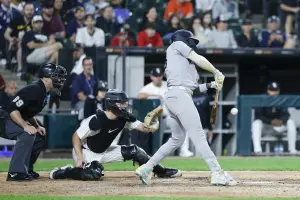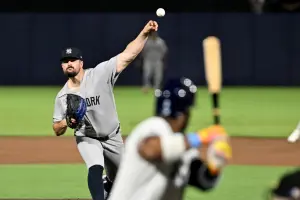
M. Meyer, Albies, Roupp, P. Smith, Liberatore
Meyer is breaking out... Max Meyer (RHP, MIA) has a 3.18 ERA, 1.21 WHIP, 33% K%, and 8% BB% in 34 innings in 2025. Meyer was awful in 2024, though he only had a small sample of data. Have any of Meyer's skills changed to support an early breakout?
| Season | IP | ERA/xERA | WHIP | H%/S% | GB%/FB% | BB% | K% | SwK% | HR/F | BPX |
| 2022 | 6 | 7.50/4.26 | 1.50 | 39%/57% | 44%/44% | 8% | 23% | 15.5% | 25% | 120 |
| 2024 | 57 | 5.68/4.38 | 1.42 | 34%/67% | 50%/36% | 8% | 19% | 10.5% | 22% | 89 |
| 2025 | 34 | 3.18/2.51 | 1.21 | 36%/78% | 55%/28% | 8% | 33% | 15.2% | 17% | 234 |
Meyer is showing some early skill changes:
- Meyer's xERA was over one run better than his actual ERA in 2024, though the skill metrics didn't excite us. He had a below-average K-BB% and SwK. However, we've seen Meyer's SwK jump to a career high, mainly via his slider, generating a 19.8% SwK in 2025. Unsurprisingly, the improved near-elite skills aligned with his xERA.
- He has been inducing more groundballs to help limit the home runs. That's mainly because of his slider (58.3%), change-up (58.3%), and sinker (66.7%), with the latter improving from his 2024 groundball rate. Meyer's change-up added nearly five inches of downward movement in 2025, giving it an above-average movement profile, which he locates lower in the zone.
- Meyer continued throwing his slider most often against right-handed hitters, with a notable increase in his sinker usage (25%), up from 2.6%. That has given him a second quality pitch against same-handed hitters, evidenced by his slider allowing a .145 wOBA (.155 xwOBA) and sinker resulting in a .323 wOBA (.295 xwOBA). Meyer's sinker has added velocity (+1.5 mph), downward movement (+2.5 inches), and horizontal fade (+1.6 inches). That gives him a pitch with induced movement between his four-seam and changeup on his arm side.
- The main pitch mix change against left-handed hitters involves Meyer throwing fewer four-seamers (24.1%) and adding a sweeper (7.2%). For context, Meyer lowered his four-seam usage by 11 percentage points. That's a positive change because Meyer's four-seamer has been one of his worst pitches versus lefties (.518 wOBA, .555 xwOBA), worse than the 2024 numbers (.456 wOBA, .413 xwOBA).
Health has been an issue for Meyer, not including his return from Tommy John surgery in 2024. Meyer's slider remains his main pitch for whiffs, but his sinker and changeup have different movement profiles, leading to potentially more whiffs and weak contact. The near-elite skills support the early breakout in 2025, so we should buy into Meyer.
Tools. Analysis. Commentary. And most of all—a tradition of winning. Access it all with a subscription to BaseballHQ.com.
A slow start or should we be concerned?... Ozzie Albies (2B, ATL) has four home runs, three stolen bases, and a .229 BA in 118 plate appearances. Albies dealt with a fractured toe and wrist in 2024, leading to an underwhelming season. Should we be worried about Albies, or is it just a slow start? Let's see what the early skills say.
| Season | PA | HR/SB | BA/xBA | ct% | h% | GB%/FB% | PX/xPX | HR/F | SB%/SBO | BPX |
| 2021 | 686 | 30/20 | .259/.259 | 80% | 28% | 31%/49% | 126/129 | 12% | 83%/18% | 258 |
| 2022 | 269 | 8/3 | .247/.251 | 81% | 28% | 38%/44% | 104/125 | 9% | 38%/15% | 162 |
| 2023 | 658 | 33/13 | .280/.280 | 82% | 29% | 38%/42% | 122/139 | 16% | 93%/10% | 257 |
| 2024 | 435 | 10/8 | .251/.259 | 84% | 28% | 38%/43% | 97/92 | 7% | 89%/10% | 193 |
| 2025 | 118 | 4/3 | .229/.247 | 86% | 23% | 33%/48% | 83/70 | 9% | 100%/12% | 197 |
If the power skills don't return, it's worrisome:
- Albies' xBA has fallen over the past two seasons, over 10 points below his career xBA (.271). He maintained the plate discipline and, interestingly, improved his contact rates, but his power skills fell to concerning levels. Albies has been more patient, with a 52.6% swing rate and 71.7% zone swing rate, both metrics sit 4-6 percentage points below his career averages. That coincides with Albies making more zone contact at a career-high rate, though it could be small sample noise.
- His power metrics fell to mediocre levels in 2024 after being above average. Unfortunately, his xPX fell to a career-low rate. Albies's power skill decline can be explained by his Quality of Batted Balls (QBaB). Albies had a DAf QBaB in 2024, indicating awful exit velocities and brutal launch angle variability. That's evident in Albies having career lows in average exit velocity and via flyballs and line drives. The launch angle variability also concerns us because it could lead to weak pop-ups, seen via a career-high infield flyball rate (17.8%), double his career average.
- Albies has seen his stolen base opportunities dip from the peak 2021 season, though he maintained his stolen base conversion rates. He can compile volume to generate 10-15 stolen bases, but that might be a bonus based on the rest of his profile. However, double-digit steals probably won't matter if he doesn't find the power skills he used to show.
Albies had a discounted price in fantasy drafts, but maybe not enough. His plate discipline has been solid, but he needs to develop power skills to return to average, or the alarms will go off. Albies already tapped into the pull-heavy (46.8%) approach often in 2025 and throughout his career, so the launch angle variability and inconsistency might be the part to fix and monitor. The downside is a Bo Bichette-like season from 2024.
Roupp warrants more attention. Landen Roupp (RHP, SF) might hurt our WHIP. In 25 innings, he has a 1.52 WHIP, 4.56 ERA, 27% K%, and 10% BB%. His WHIP is worse than his rookie season, but he has transitioned into a starter in 2025. Let's examine Roupp's skills to see if they suggest better outcomes.
| Season | IP | ERA/xERA | WHIP | H%/S% | GB%/FB% | Ball% | BB% | K% | SwK% | HR/F | BPX |
| 2024 | 50.1 | 3.58/4.25 | 1.37 | 30%/73% | 47%/29% | 38% | 12% | 22% | 9.8% | 5% | 58 |
| 2025 | 25.2 | 4.56/3.59 | 1.52 | 39%/72% | 42%/34% | 40% | 10% | 27% | 13.4% | 13% | 150 |
Roupp needs the whiffs to offset the control:
- When a pitcher's xERA is better than the actual number, it typically tells us the skills hint at better outcomes. Roupp falls into that bucket, with a high-end SwK. That mainly comes via Roupp's curveball (22.3%) and change-up (15.4%) SwK. His change-up decreased by nearly one percentage point, and the curveball skyrocketed seven points in 2025.
- Since Roupp has a lower arm angle (26 degrees), he uses tons of curveballs (47%) and sinkers (43%) against right-handed hitters. Meanwhile, Roupp mixes in sinkers (37.6%), curves (34.8%), change-ups (17.1%), and cutters (10.5%) to lefties. Roupp's arm angle typically lends itself toward pitches that move side to side, which we've seen with his usage and pitch movement profiles.
- The curve performs the best versus right-handed hitters, allowing a .287 wOBA (.289 xwOBA). Roupp's curveball showed elite outcomes, evidenced by a .000 wOBA (0.097 xwOBA) versus lefties. Besides the curveball, Roupp's sinker has been his next-best offering against lefties (.312 wOBA, .315 xwOBA). However, it's hard to say the same against righties, with the sinker allowing a .435 wOBA, yet the expected numbers hint at regression (.286 xwOBA).
With Roupp using a lower arm angle, translating to tons of horizontal movement, we might see some inconsistencies with his whiffs. Typically, pitches that generate more horizontal movement lead toward weak contact instead of whiffs. However, Roupp's change-up generates elite levels of downward movement, with the sinker and curveball having above-average horizontal profiles. Pitchers like Roupp, who struggle with control (40% Ball%), need to elicit whiffs in their arsenal. Roupp has been generating whiffs, but he'll hurt our WHIP if he can't improve the control or suppress the hit rates. Roupp is a streaming pitcher with strikeout upside.
Smith has mainly been a part-time player... Pavin Smith (OF, ARI) has hit four home runs, one stolen base, and a .333 BA in 86 plate appearances. Smith hasn't surpassed 500 plate appearances since 2021 in his six-year career. Is Smith's hot start fluky or legitimate?
| Season | PA | HR/SB | BA/xBA | BB% | ct% | h% | GB%/FB% | PX/xPX | HR/F | BPX |
| 2021 | 545 | 11/1 | .267/.253 | 8% | 79% | 32% | 47%/32% | 81/92 | 9% | 131 |
| 2022 | 277 | 9/1 | .220/.210 | 10% | 73% | 27% | 43%/43% | 97/92 | 12% | 66 |
| 2023 | 227 | 7/1 | .189/.232 | 15% | 76% | 21% | 43%/38% | 76/101 | 13% | 82 |
| 2024 | 158 | 9/1 | .270/.299 | 11% | 77% | 29% | 43%/38% | 172/139 | 22% | 339 |
| 2025 | 86 | 4/1 | .333/.298 | 20% | 64% | 48% | 50%/30% | 258/136 | 31% | 440 |
Smith made notable skill and approach changes, but expect some regression:
- Smith had a decent contact rate in his career (76%), but it's fallen to 64% in 2025. He hasn't been chasing more often, and his zone contact rates have fallen. That hints at him potentially selling out for power, evident by his pull rates rising from 45% (2024) to 59.1% (2025).
- Smith's heavy pull rate has increased his power metrics over the past two seasons, shifting from high-end to near-elite levels of xPX. We can see that via Smith's ACa QBaB, too.
- Smith's HR/F has skyrocketed over the past two seasons, though it's a relatively small sample. However, Smith displayed the power skills to back up the higher home run rates. According to the Baseball Forecaster, Smith's HR/F should regress since hitters typically showed a 21.5% HR/F as the 90th percentile outcome based on his xPX.
When a hitter performs well, we expect a mixture of luck and skills. That's the case with Smith since the h% and HR/F have boosted his batting average and home runs. That's further evident in his PX versus xPX, though his power skills supported the output. The lefty splits will be an issue, with most of his career plate appearances coming versus righties (78.2%). Smith's dominance against right-handed pitchers shows up with a 210 wRC+ in 2025, fueled by a 50% hit rate and .485 wOBA. Expect those numbers to regress closer to his career averages in wRC+ (115) and hit rate (29%) versus righties. Smith's hot start is mostly legitimate, but let's bake in some regression.
Is Liberatore figuring things out?... Matthew Liberatore (LHP, STL) has mostly been a reliever over the past two seasons, with some starts. In the early 2025 sample, Liberatore has a 3.19 ERA, 0.97 WHIP, 23% K%, and 2% BB% in 31 innings. Has he made notable skill changes?
| Season | G/GS | IP | ERA/xERA | WHIP | H%/S% | GB%/FB% | Ball% | BB% | K% | SwK% | BPX |
| 2022 | 9/7 | 34.2 | 5.97/5.29 | 1.73 | 37%/67% | 38%/37% | 40% | 12% | 17% | 9.0% | 25 |
| 2023 | 22/11 | 61.2 | 5.25/5.07 | 1.48 | 33%/64% | 43%/34% | 39% | 9% | 17% | 7.5% | 51 |
| 2024 | 60/6 | 86 | 4.40/4.20 | 1.27 | 32%/68% | 41%/39% | 33% | 8% | 21% | 12.2% | 96 |
| 2025 | 5/5 | 31 | 3.19/3.04 | 0.97 | 31%/66% | 44%/31% | 33% | 2% | 23% | 11.8% | 200 |
Liberatore is evolving before our eyes:
- Liberatore's xERA is slightly better than his actual ERA, with a career-best K-BB% and decent SwK to support the outcomes. He flashed better control in 2025, with a 32.6% ball rate, over three percentage points below his career average (36.3%).
- Liberatore's curveball was his calling card as a prospect, but he has been ditching it for sliders. His slider (28.7%) and four-seamer (25.3%) lead the overall arsenal, with an even distribution of sliders against righties (22.5%) and lefties (43%), as one of his most-used offerings. The slider leads his arsenal, with a 22.7% SwK, over 3.5 points higher than his career average.
- His slider added two inches of downward movement and gained an inch of horizontal movement while maintaining the velocity from 2024. The slider performs decently against righties (.261 wOBA, .334 xwOBA), but it's a nasty option versus lefties (.145 wOBA, .248 xwOBA). He locates the slider down and away from left-handed hitters. Liberatore might be commanding it well because he has been throwing it four points more in the zone (50.4%), yet it generates a chase rate over 11 percentage points higher than 2024.
- Besides the slider, Liberatore's change-up (.099 wOBA, .291 xwOBA) and sinker (.191 wOBA, .276 xwOBA) have been his two other quality pitches against right-handed hitters. Meanwhile, only the four-seamer performs well versus left-handed hitters (.227 wOBA, .231 xwOBA), not including the slider.
If Liberatore maintains the high-end control, this approach can work where he has two pitches to attack both sides of the plate while generating a decent amount of whiffs. With Liberatore's higher arm angle, his extension is below average. That means he should locate his four-seam in the upper third of the zone, especially considering the mediocre induced vertical break. Since we're examining a small sample, it's fair to have skepticism about Liberatore, making him more relevant as a deep-league streamer. His arsenal and approach have positively evolved in 2025.







